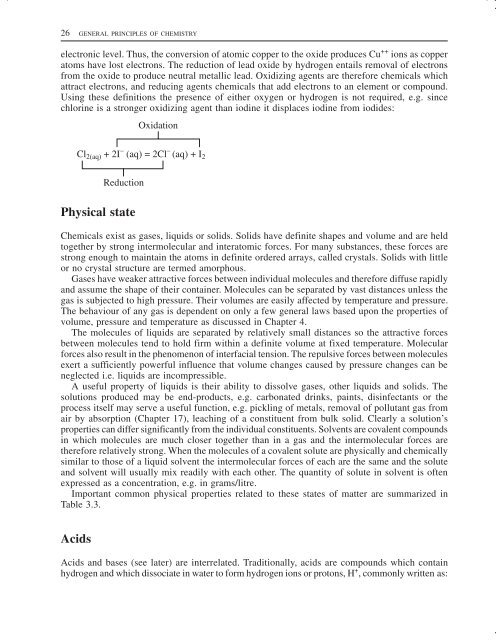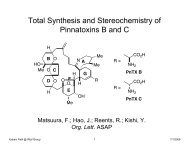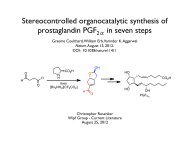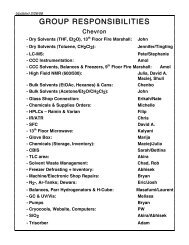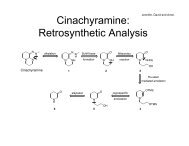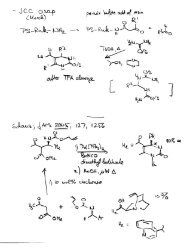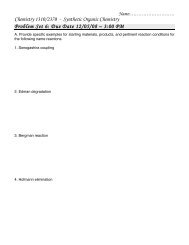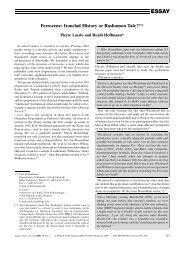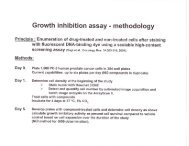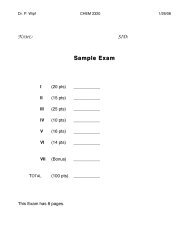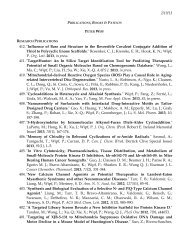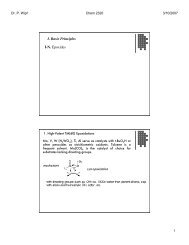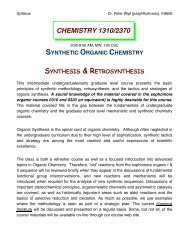- Page 1: Hazardous Chemicals Handbook
- Page 4 and 5: Butterworth-Heinemann An imprint of
- Page 6 and 7: vi CONTENTS Effects of particle or
- Page 8 and 9: viii CONTENTS 14 Marketing 443 Clas
- Page 10 and 11: x PREFACE TO THE SECOND EDITION The
- Page 12 and 13: xii PREFACE to chemical safety data
- Page 14 and 15: 2 INTRODUCTION Table 1.1 Breakdown
- Page 16 and 17: 4 INTRODUCTION Table 1.3 Comprehens
- Page 18 and 19: 6 INTRODUCTION Table 1.5 Schedule 1
- Page 20 and 21: 8 INTRODUCTION Table 1.7 Planning (
- Page 22 and 23: 2 Terminology ACID A chemical compo
- Page 24 and 25: 12 TERMINOLOGY initially thought to
- Page 26 and 27: 14 TERMINOLOGY vapour concentration
- Page 28 and 29: 16 TERMINOLOGY MULTIPLE CHEMICAL SE
- Page 30 and 31: 18 TERMINOLOGY conferences of the s
- Page 32 and 33: 20 TERMINOLOGY UEL, UPPER EXPLOSIVE
- Page 34 and 35: 22 GENERAL PRINCIPLES OF CHEMISTRY
- Page 36 and 37: 24 GENERAL PRINCIPLES OF CHEMISTRY
- Page 40 and 41: 28 GENERAL PRINCIPLES OF CHEMISTRY
- Page 42 and 43: 30 GENERAL PRINCIPLES OF CHEMISTRY
- Page 44 and 45: 32 GENERAL PRINCIPLES OF CHEMISTRY
- Page 46 and 47: 34 GENERAL PRINCIPLES OF CHEMISTRY
- Page 48 and 49: 36 GENERAL PRINCIPLES OF CHEMISTRY
- Page 50 and 51: 38 GENERAL PRINCIPLES OF CHEMISTRY
- Page 52 and 53: 40 GENERAL PRINCIPLES OF CHEMISTRY
- Page 54 and 55: 42 GENERAL PRINCIPLES OF CHEMISTRY
- Page 56 and 57: 44 GENERAL PRINCIPLES OF CHEMISTRY
- Page 58 and 59: 46 PHYSICOCHEMISTRY pa = pa′ xa w
- Page 60 and 61: 48 PHYSICOCHEMISTRY Table 4.1 Densi
- Page 62 and 63: 50 PHYSICOCHEMISTRY Vapour flashing
- Page 64 and 65: 52 PHYSICOCHEMISTRY where N is mass
- Page 66 and 67: 54 PHYSICOCHEMISTRY where T a is th
- Page 68 and 69: 56 PHYSICOCHEMISTRY Table 4.8 Compa
- Page 70 and 71: 58 PHYSICOCHEMISTRY Table 4.10 Corr
- Page 72 and 73: 60 PHYSICOCHEMISTRY Table 4.12 Solv
- Page 74 and 75: 62 PHYSICOCHEMISTRY Table 4.13 Cont
- Page 76 and 77: 64 PHYSICOCHEMISTRY Table 4.13 Cont
- Page 78 and 79: 66 PHYSICOCHEMISTRY If pressure rel
- Page 80 and 81: 68 TOXIC CHEMICALS Table 5.1 Classi
- Page 82 and 83: 70 TOXIC CHEMICALS Table 5.2 Materi
- Page 84 and 85: 72 TOXIC CHEMICALS A summary of the
- Page 86 and 87: 74 TOXIC CHEMICALS Table 5.4 Cont
- Page 88 and 89:
76 TOXIC CHEMICALS Table 5.6 Some s
- Page 90 and 91:
78 TOXIC CHEMICALS 10 6 Boulders 10
- Page 92 and 93:
80 TOXIC CHEMICALS Table 5.10 Chemi
- Page 94 and 95:
Threshold limit values (TLV) These
- Page 96 and 97:
(a) should not be used as an index
- Page 98 and 99:
Table 5.13 Adopted biological expos
- Page 100 and 101:
Table 5.13 Cont’d METHYL ETHYL KE
- Page 102 and 103:
Table 5.14 UK biological monitoring
- Page 104 and 105:
Table 5.16 Substances assigned ‘R
- Page 106 and 107:
Table 5.16 Cont’d Ethyleneimine E
- Page 108 and 109:
Table 5.17 Evaluation of carcinogen
- Page 110 and 111:
Table 5.17 Cont’d RISK CONTROL 12
- Page 112 and 113:
Table 5.17 Cont’d Non-arsenical i
- Page 114 and 115:
Table 5.17 Cont’d 2-(2-Formylhydr
- Page 116 and 117:
Table 5.17 Cont’d Uracil mustard
- Page 118 and 119:
(e.g. with knock-out and/or scrubbi
- Page 120 and 121:
Typical minimum transport velocitie
- Page 122 and 123:
Table 5.20 Prohibition of certain s
- Page 124 and 125:
Keep test records Keep RPE test rec
- Page 126 and 127:
extend with certain exceptions to o
- Page 128 and 129:
Table 5.23 Frequency of thorough ex
- Page 130 and 131:
Table 5.26 Agents for which health
- Page 132 and 133:
Table 5.27 Summary of precautions f
- Page 134 and 135:
Long-term exposure to ferric oxide
- Page 136 and 137:
The STEL is 200 ppm but extended pe
- Page 138 and 139:
(iv) Cyanides As a group, the cyani
- Page 140 and 141:
Basic precautions include those in
- Page 142 and 143:
Table 5.38 Chlorinated hydrocarbon
- Page 144 and 145:
Table 5.40 Routine laboratory preca
- Page 146 and 147:
Table 5.43 Common anhydrous acids C
- Page 148 and 149:
Table 5.45 Precautions in handling
- Page 150 and 151:
Table 5.48 Potential pollutants fro
- Page 152 and 153:
Table 5.51 Physical properties of t
- Page 154 and 155:
Whilst the causative agent(s) have
- Page 156 and 157:
Table 5.54 Precautions to avoid ‘
- Page 158 and 159:
Table 5.57 General precautions with
- Page 160 and 161:
Monitor effectiveness Assess weldin
- Page 162 and 163:
Ammonium chloride fume - 10 - 20 -
- Page 164 and 165:
tert-Butyl acetate 200 950 - - 200
- Page 166 and 167:
2-Chloroethanol, see Ethylene chlor
- Page 168 and 169:
1,2-Dibromoethane, see Ethylene dib
- Page 170 and 171:
Dinitolmide - 5 - - - - - - Dinitro
- Page 172 and 173:
Ethyl ether 400 1210 500 1520 400 1
- Page 174 and 175:
Hydrogen bromide - - C3 C9.9 - - 3
- Page 176 and 177:
Inorganic forms including metallic
- Page 178 and 179:
Mineral wool fibre - 10 (i) Molybde
- Page 180 and 181:
Perlite - 10 (i) Petroleum distilla
- Page 182 and 183:
Quinone 0.1 0.44 - - 0.1 0.4 0.3 1.
- Page 184 and 185:
Synthetic vitreous fibres Continuou
- Page 186 and 187:
Tricyclohexyltin hydroxide, see Cyh
- Page 188 and 189:
(d) Simple asphyxiant. Some gases a
- Page 190 and 191:
6 Flammable chemicals Certain chemi
- Page 192 and 193:
198 FLAMMABLE CHEMICALS these are n
- Page 194 and 195:
Table 6.3 Sources of ignition Mecha
- Page 196 and 197:
Table 6.4 Approximate temperatures
- Page 198 and 199:
Table 6.6 Approximate temperatures
- Page 200 and 201:
Table 6.7 Cont’d Wood flour Wool
- Page 202 and 203:
Table 6.10 Electrochemical series M
- Page 204 and 205:
Table 6.11 Control measures for wor
- Page 206 and 207:
• The type of hazard - determines
- Page 208 and 209:
Table 6.13 General requirements for
- Page 210 and 211:
The minimum fire instruction and tr
- Page 212 and 213:
n-Amyl alcohol 0.82 3.0 33 300 1-10
- Page 214 and 215:
Butyl cellosolve 0.91 4.1 61 244 1.
- Page 216 and 217:
Cumene 0.86 4.1 44 424 0.9-6.5 152
- Page 218 and 219:
Diethyl sulphate Diglycol, see Diet
- Page 220 and 221:
Ethylene chlorohydrin 1.21 2.78 60o
- Page 222 and 223:
p-Mentha-1,8-diene 3.84 7.4 45 237
- Page 224 and 225:
Nitroethane 1.05 2.58 38 360-415 3.
- Page 226 and 227:
Propionitrile 0.77 1.9 2 - 3.1- 97
- Page 228 and 229:
Trimethyl amine 0.66 2.0 -7 190 2-1
- Page 230 and 231:
Benzoyl peroxide - - - 21 - Berylli
- Page 232 and 233:
Copper-zinc, gold bronze 370 190 1.
- Page 234 and 235:
Hydrazine acid tartrate 570 0.175 4
- Page 236 and 237:
Phthalimide 630 - 0.030 50 89 4800
- Page 238 and 239:
Sodium toluene sulphonate 530 - - -
- Page 240 and 241:
7 Reactive chemicals From Chapter 3
- Page 242 and 243:
230 REACTIVE CHEMICALS Table 7.1 Wa
- Page 244 and 245:
232 REACTIVE CHEMICALS Table 7.3 Va
- Page 246 and 247:
234 REACTIVE CHEMICALS (e.g. concen
- Page 248 and 249:
236 REACTIVE CHEMICALS Table 7.7 At
- Page 250 and 251:
238 REACTIVE CHEMICALS Table 7.9 Se
- Page 252 and 253:
240 REACTIVE CHEMICALS Table 7.9 Co
- Page 254 and 255:
242 REACTIVE CHEMICALS Table 7.11 C
- Page 256 and 257:
244 REACTIVE CHEMICALS High e.g. sl
- Page 258 and 259:
246 REACTIVE CHEMICALS Table 7.14 S
- Page 260 and 261:
248 REACTIVE CHEMICALS Table 7.17 G
- Page 262 and 263:
250 REACTIVE CHEMICALS Table 7.20 P
- Page 264 and 265:
252 REACTIVE CHEMICALS Incorrect ki
- Page 266 and 267:
254 REACTIVE CHEMICALS Table 7.22 H
- Page 268 and 269:
256 REACTIVE CHEMICALS Erlenmeyer r
- Page 270 and 271:
8 Cryogens Cryogenics, or low-tempe
- Page 272 and 273:
260 CRYOGENS Table 8.3 General prec
- Page 274 and 275:
262 CRYOGENS to liquefy. The triple
- Page 276 and 277:
264 CRYOGENS Table 8.6 Effect of ca
- Page 278 and 279:
266 COMPRESSED GASES Table 9.1 Comp
- Page 280 and 281:
268 COMPRESSED GASES Table 9.1 Cont
- Page 282 and 283:
270 COMPRESSED GASES Table 9.1 Cont
- Page 284 and 285:
272 COMPRESSED GASES Table 9.3 prov
- Page 286 and 287:
274 COMPRESSED GASES Table 9.4 Phys
- Page 288 and 289:
276 COMPRESSED GASES The precaution
- Page 290 and 291:
278 COMPRESSED GASES Vapour pressur
- Page 292 and 293:
280 COMPRESSED GASES CO + Cl 2 →
- Page 294 and 295:
282 COMPRESSED GASES Vapour pressur
- Page 296 and 297:
284 COMPRESSED GASES Hydrogen chlor
- Page 298 and 299:
286 COMPRESSED GASES • Avoid galv
- Page 300 and 301:
288 COMPRESSED GASES Vapour pressur
- Page 302 and 303:
290 COMPRESSED GASES Vapour pressur
- Page 304 and 305:
292 COMPRESSED GASES Table 9.16 Gen
- Page 306 and 307:
294 COMPRESSED GASES Vapour pressur
- Page 308 and 309:
296 COMPRESSED GASES Table 9.20 Phy
- Page 310 and 311:
298 COMPRESSED GASES Table 9.22 Phy
- Page 312 and 313:
300 COMPRESSED GASES Vapour pressur
- Page 314 and 315:
302 COMPRESSED GASES 16 hr per day
- Page 316 and 317:
304 COMPRESSED GASES where R 1 and
- Page 318 and 319:
306 COMPRESSED GASES Table 9.26 Phy
- Page 320 and 321:
308 MONITORING TECHNIQUES Table 10.
- Page 322 and 323:
310 MONITORING TECHNIQUES such that
- Page 324 and 325:
312 MONITORING TECHNIQUES Table 10.
- Page 326 and 327:
314 MONITORING TECHNIQUES industria
- Page 328 and 329:
316 MONITORING TECHNIQUES Table 10.
- Page 330 and 331:
318 MONITORING TECHNIQUES Table 10.
- Page 332 and 333:
Table 10.12 Selected examples of sa
- Page 334 and 335:
Table 10.15 Charcoal tube user guid
- Page 336 and 337:
Table 10.15 Cont’d Substance Expe
- Page 338 and 339:
Table 10.15 Cont’d Substance Expe
- Page 340 and 341:
Table 10.15 Cont’d Substance Expe
- Page 342 and 343:
330 MONITORING TECHNIQUES Table 10.
- Page 344 and 345:
332 MONITORING TECHNIQUES Table 10.
- Page 346 and 347:
Table 10.17 Compounds detectable by
- Page 348 and 349:
Table 10.17 Cont’d Compound Analy
- Page 350 and 351:
Table 10.17 Cont’d Compound Analy
- Page 352 and 353:
Table 10.17 Cont’d Compound Analy
- Page 354 and 355:
342 MONITORING TECHNIQUES Table 10.
- Page 356 and 357:
344 MONITORING TECHNIQUES Table 10.
- Page 358 and 359:
346 MONITORING TECHNIQUES Table 10.
- Page 360 and 361:
348 MONITORING TECHNIQUES Table 10.
- Page 362 and 363:
350 MONITORING TECHNIQUES Table 10.
- Page 364 and 365:
352 MONITORING TECHNIQUES Table 10.
- Page 366 and 367:
354 MONITORING TECHNIQUES Table 10.
- Page 368 and 369:
Table 10.23 Cont’d Principle Exam
- Page 370 and 371:
358 MONITORING TECHNIQUES Table 10.
- Page 372 and 373:
360 MONITORING TECHNIQUES Table 10.
- Page 374 and 375:
362 MONITORING TECHNIQUES Table 10.
- Page 376 and 377:
364 MONITORING TECHNIQUES Table 10.
- Page 378 and 379:
366 MONITORING TECHNIQUES Table 10.
- Page 380 and 381:
368 MONITORING TECHNIQUES Table 10.
- Page 382 and 383:
370 MONITORING TECHNIQUES Table 10.
- Page 384 and 385:
Table 10.30 Methods for sampling an
- Page 386 and 387:
Table 10.30 Cont’d Substance Samp
- Page 388 and 389:
Table 10.30 Cont’d Substance Samp
- Page 390 and 391:
Table 10.30 Cont’d Substance Samp
- Page 392 and 393:
Table 10.30 Cont’d Substance Samp
- Page 394 and 395:
Table 10.30 Cont’d Substance Samp
- Page 396 and 397:
Table 10.30 Cont’d Substance Samp
- Page 398 and 399:
386 MONITORING TECHNIQUES Existing
- Page 400 and 401:
388 MONITORING TECHNIQUES Table 10.
- Page 402 and 403:
11 Radioactive chemicals The main c
- Page 404 and 405:
392 RADIOACTIVE CHEMICALS Table 11.
- Page 406 and 407:
394 RADIOACTIVE CHEMICALS D t = D 0
- Page 408 and 409:
12 Safety by design Plant and equip
- Page 410 and 411:
398 SAFETY BY DESIGN Table 12.2 Che
- Page 412 and 413:
400 SAFETY BY DESIGN Table 12.5 Fea
- Page 414 and 415:
402 SAFETY BY DESIGN Table 12.7 Sel
- Page 416 and 417:
404 SAFETY BY DESIGN Equipment desi
- Page 418 and 419:
406 SAFETY BY DESIGN Table 12.11 Sa
- Page 420 and 421:
408 SAFETY BY DESIGN Table 12.12 Ra
- Page 422 and 423:
410 SAFETY BY DESIGN Table 12.13 Co
- Page 424 and 425:
13 Operating procedures Safety is a
- Page 426 and 427:
414 OPERATING PROCEDURES Table 13.1
- Page 428 and 429:
416 OPERATING PROCEDURES Table 13.1
- Page 430 and 431:
418 OPERATING PROCEDURES Work can b
- Page 432 and 433:
420 OPERATING PROCEDURES PLANT DETA
- Page 434 and 435:
422 OPERATING PROCEDURES CERTIFICAT
- Page 436 and 437:
424 OPERATING PROCEDURES • Have e
- Page 438 and 439:
426 OPERATING PROCEDURES Calling in
- Page 440 and 441:
428 OPERATING PROCEDURES Table 13.5
- Page 442 and 443:
430 OPERATING PROCEDURES Cuts is un
- Page 444 and 445:
432 OPERATING PROCEDURES Table 13.8
- Page 446 and 447:
434 OPERATING PROCEDURES Table 13.9
- Page 448 and 449:
436 OPERATING PROCEDURES There are
- Page 450 and 451:
438 OPERATING PROCEDURES Table 13.1
- Page 452 and 453:
440 OPERATING PROCEDURES Table 13.1
- Page 454 and 455:
442 OPERATING PROCEDURES Monitoring
- Page 456 and 457:
444 MARKETING Table 14.1 Legislatio
- Page 458 and 459:
446 MARKETING Table 14.2 Indication
- Page 460 and 461:
448 MARKETING Table 14.3 ‘Risk’
- Page 462 and 463:
450 MARKETING Table 14.3 Cont’d 4
- Page 464 and 465:
452 MARKETING Table 14.5 Classifica
- Page 466 and 467:
454 MARKETING Table 14.6 Cont’d C
- Page 468 and 469:
456 MARKETING Table 14.9 Compatibil
- Page 470 and 471:
458 MARKETING • Substances intend
- Page 472 and 473:
15 Transport of chemicals Transport
- Page 474 and 475:
462 TRANSPORT OF CHEMICALS Legislat
- Page 476 and 477:
464 TRANSPORT OF CHEMICALS • in a
- Page 478 and 479:
466 TRANSPORT OF CHEMICALS Table 15
- Page 480 and 481:
468 TRANSPORT OF CHEMICALS Table 15
- Page 482 and 483:
470 TRANSPORT OF CHEMICALS Table 15
- Page 484 and 485:
472 TRANSPORT OF CHEMICALS Table 15
- Page 486 and 487:
474 TRANSPORT OF CHEMICALS Table 15
- Page 488 and 489:
476 TRANSPORT OF CHEMICALS Table 15
- Page 490 and 491:
478 TRANSPORT OF CHEMICALS Table 15
- Page 492 and 493:
480 TRANSPORT OF CHEMICALS Table 15
- Page 494 and 495:
482 TRANSPORT OF CHEMICALS water sp
- Page 496 and 497:
484 TRANSPORT OF CHEMICALS Table 15
- Page 498 and 499:
486 TRANSPORT OF CHEMICALS Table 15
- Page 500 and 501:
16 Chemicals and the environment: s
- Page 502 and 503:
490 CHEMICALS AND THE ENVIRONMENT:
- Page 504 and 505:
492 CHEMICALS AND THE ENVIRONMENT:
- Page 506 and 507:
494 CHEMICALS AND THE ENVIRONMENT:
- Page 508 and 509:
496 CHEMICALS AND THE ENVIRONMENT:
- Page 510 and 511:
498 CHEMICALS AND THE ENVIRONMENT:
- Page 512 and 513:
500 CHEMICALS AND THE ENVIRONMENT:
- Page 514 and 515:
502 CHEMICALS AND THE ENVIRONMENT:
- Page 516 and 517:
504 CHEMICALS AND THE ENVIRONMENT:
- Page 518 and 519:
506 CHEMICALS AND THE ENVIRONMENT:
- Page 520 and 521:
508 CHEMICALS AND THE ENVIRONMENT:
- Page 522 and 523:
510 CHEMICALS AND THE ENVIRONMENT:
- Page 524 and 525:
17 Chemicals and the environment: m
- Page 526 and 527:
514 CHEMICALS AND THE ENVIRONMENT D
- Page 528 and 529:
516 CHEMICALS AND THE ENVIRONMENT T
- Page 530 and 531:
518 CHEMICALS AND THE ENVIRONMENT T
- Page 532 and 533:
520 CHEMICALS AND THE ENVIRONMENT T
- Page 534 and 535:
522 CHEMICALS AND THE ENVIRONMENT T
- Page 536 and 537:
524 CHEMICALS AND THE ENVIRONMENT T
- Page 538 and 539:
526 CHEMICALS AND THE ENVIRONMENT T
- Page 540 and 541:
528 CHEMICALS AND THE ENVIRONMENT A
- Page 542 and 543:
530 CHEMICALS AND THE ENVIRONMENT P
- Page 544 and 545:
532 CHEMICALS AND THE ENVIRONMENT T
- Page 546 and 547:
534 CHEMICALS AND THE ENVIRONMENT T
- Page 548 and 549:
536 CHEMICALS AND THE ENVIRONMENT T
- Page 550 and 551:
538 CHEMICALS AND THE ENVIRONMENT T
- Page 552 and 553:
540 CHEMICALS AND THE ENVIRONMENT T
- Page 554 and 555:
542 CHEMICALS AND THE ENVIRONMENT T
- Page 556 and 557:
544 CONVERSION TABLES AND MEASUREME
- Page 558 and 559:
546 CONVERSION TABLES AND MEASUREME
- Page 560 and 561:
548 CONVERSION TABLES AND MEASUREME
- Page 562 and 563:
Emission rates To obtain: g/s g/min
- Page 564 and 565:
19 Bibliography It is impractical t
- Page 566 and 567:
554 BIBLIOGRAPHY Be Prepared for an
- Page 568 and 569:
556 BIBLIOGRAPHY Kletz, T.A. (1989)
- Page 570 and 571:
558 BIBLIOGRAPHY Selected statutory
- Page 572 and 573:
560 BIBLIOGRAPHY European legislati
- Page 574 and 575:
562 BIBLIOGRAPHY 95/50/EC Directive
- Page 576 and 577:
564 BIBLIOGRAPHY 2000/166/EC Decisi
- Page 578 and 579:
566 BIBLIOGRAPHY European legislati
- Page 580 and 581:
568 BIBLIOGRAPHY SI 1989/1149 Contr
- Page 582 and 583:
570 BIBLIOGRAPHY Selected decisions
- Page 584 and 585:
572 BIBLIOGRAPHY BPM 20 Iron works
- Page 586 and 587:
574 BIBLIOGRAPHY EH 65/30 Review of
- Page 588 and 589:
576 BIBLIOGRAPHY HS(G)123 Working t
- Page 590 and 591:
578 BIBLIOGRAPHY INDG 136 COSHH: a
- Page 592 and 593:
580 BIBLIOGRAPHY L73 RIDDOR explain
- Page 594 and 595:
582 BIBLIOGRAPHY MDHS 70 General me
- Page 596 and 597:
584 BIBLIOGRAPHY SHW 396 Effects of
- Page 598 and 599:
586 BIBLIOGRAPHY Publications by th
- Page 600 and 601:
588 BIBLIOGRAPHY BS 3951 (Withdrawn
- Page 602 and 603:
590 BIBLIOGRAPHY BS EN 54-2 Fire de
- Page 604 and 605:
592 BIBLIOGRAPHY BS EN 60079-14 AMD
- Page 606 and 607:
594 APPENDIX: SELECTED UK LEGISLATI
- Page 608 and 609:
596 APPENDIX: SELECTED UK LEGISLATI
- Page 610 and 611:
Absorption: gas, 314 percutaneous,
- Page 612 and 613:
systems of work, See Systems of wor
- Page 614 and 615:
Gloves, See Hand protection Glutera
- Page 616 and 617:
physical properties, 301 precaution
- Page 618 and 619:
Spillage, 427, 428, 429 Spontaneous


